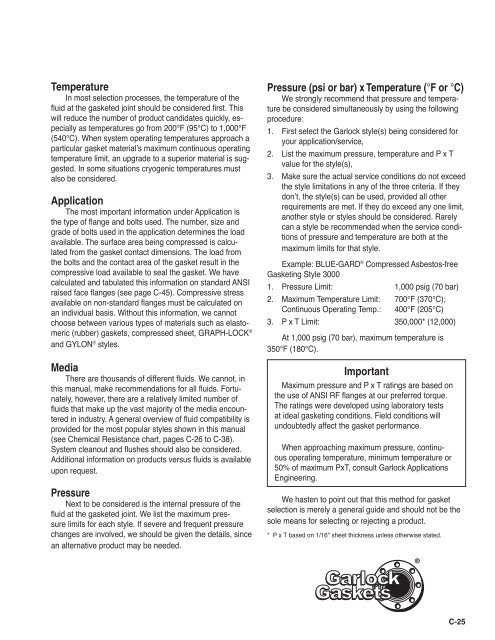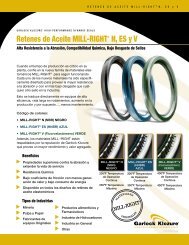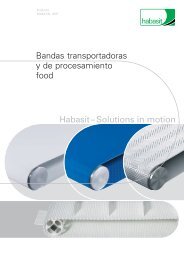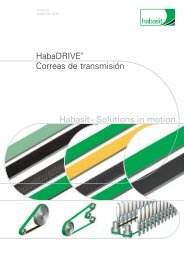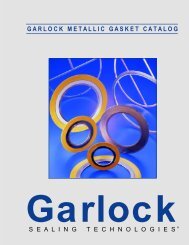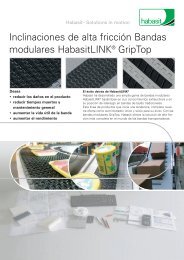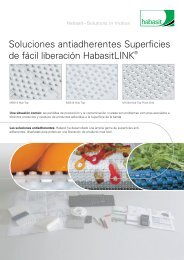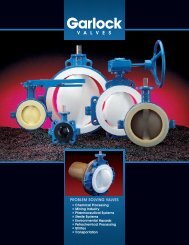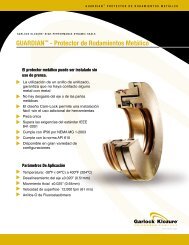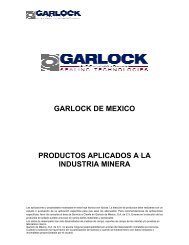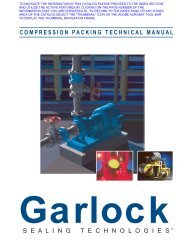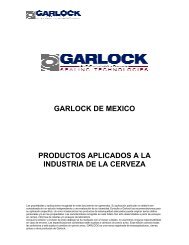Engineered Gasketing Products
Engineered Gasketing Products
Engineered Gasketing Products
- No tags were found...
You also want an ePaper? Increase the reach of your titles
YUMPU automatically turns print PDFs into web optimized ePapers that Google loves.
TemperatureIn most selection processes, the temperature of thefluid at the gasketed joint should be considered first. Thiswill reduce the number of product candidates quickly, especiallyas temperatures go from 200°F (95°C) to 1,000°F(540°C). When system operating temperatures approach aparticular gasket materialʼs maximum continuous operatingtemperature limit, an upgrade to a superior material is suggested.In some situations cryogenic temperatures mustalso be considered.ApplicationThe most important information under Application isthe type of flange and bolts used. The number, size andgrade of bolts used in the application determines the loadavailable. The surface area being compressed is calculatedfrom the gasket contact dimensions. The load fromthe bolts and the contact area of the gasket result in thecompressive load available to seal the gasket. We havecalculated and tabulated this information on standard ANSIraised face flanges (see page C-45). Compressive stressavailable on non-standard flanges must be calculated onan individual basis. Without this information, we cannotchoose between various types of materials such as elastomeric(rubber) gaskets, compressed sheet, GRAPH-LOCK ®and GYLON ® styles.MediaThere are thousands of different fluids. We cannot, inthis manual, make recommendations for all fluids. Fortunately,however, there are a relatively limited number offluids that make up the vast majority of the media encounteredin industry. A general overview of fluid compatibility isprovided for the most popular styles shown in this manual(see Chemical Resistance chart, pages C-26 to C-38).System cleanout and flushes should also be considered.Additional information on products versus fluids is availableupon request.PressureNext to be considered is the internal pressure of thefluid at the gasketed joint. We list the maximum pressurelimits for each style. If severe and frequent pressurechanges are involved, we should be given the details, sincean alternative product may be needed.Pressure (psi or bar) x Temperature (°F or °C)We strongly recommend that pressure and temperaturebe considered simultaneously by using the followingprocedure:1. First select the Garlock style(s) being considered foryour application/service,2. List the maximum pressure, temperature and P x Tvalue for the style(s),3. Make sure the actual service conditions do not exceedthe style limitations in any of the three criteria. If theydonʼt, the style(s) can be used, provided all otherrequirements are met. If they do exceed any one limit,another style or styles should be considered. Rarelycan a style be recommended when the service conditionsof pressure and temperature are both at themaximum limits for that style.Example: BLUE-GARD ® Compressed Asbestos-free<strong>Gasketing</strong> Style 30001. Pressure Limit: 1,000 psig (70 bar)2. Maximum Temperature Limit: 700°F (370°C);Continuous Operating Temp.: 400°F (205°C)3. P x T Limit: 350,000* (12,000)At 1,000 psig (70 bar), maximum temperature is350°F (180°C).ImportantMaximum pressure and P x T ratings are based onthe use of ANSI RF flanges at our preferred torque.The ratings were developed using laboratory testsat ideal gasketing conditions. Field conditions willundoubtedly affect the gasket performance.When approaching maximum pressure, continuousoperating temperature, minimum temperature or50% of maximum PxT, consult Garlock ApplicationsEngineering.We hasten to point out that this method for gasketselection is merely a general guide and should not be thesole means for selecting or rejecting a product.* P x T based on 1/16" sheet thickness unless otherwise stated.GarlockGaskets®C-25


